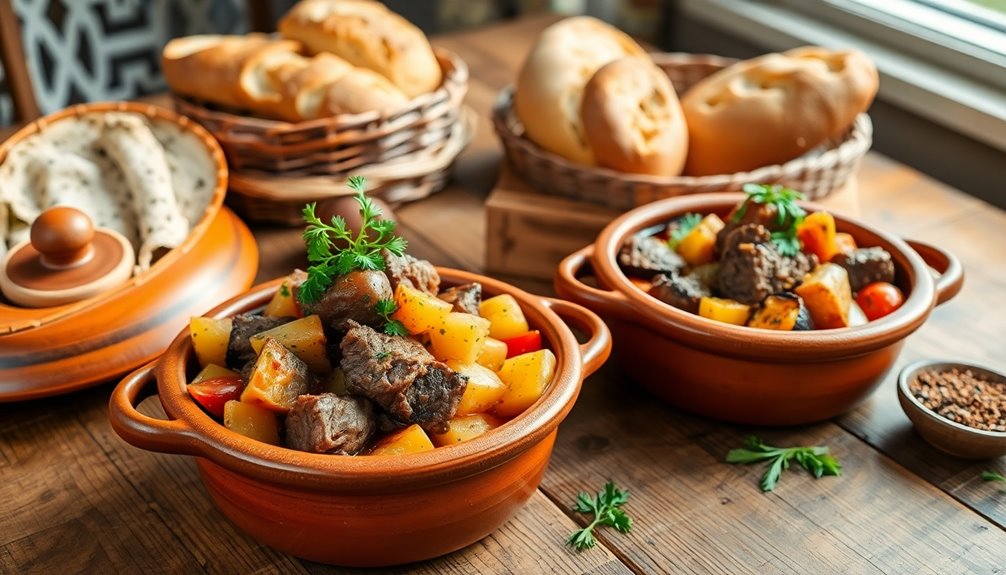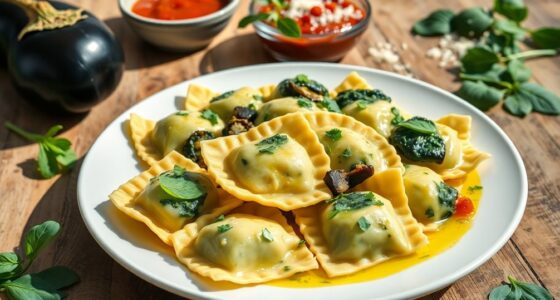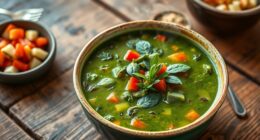Chanakhi is a traditional Georgian lamb stew that showcases rich flavors and communal dining. You'll layer fresh ingredients like lamb, eggplant, and tomatoes in clay pots, slowly cooking them to perfection. This dish captures the essence of Georgian hospitality and culinary heritage, making it perfect for special occasions or family gatherings. Its warmth makes it ideal for colder months, ensuring comfort and nostalgia. Curious about the recipe and cooking techniques? There's more to discover!
History
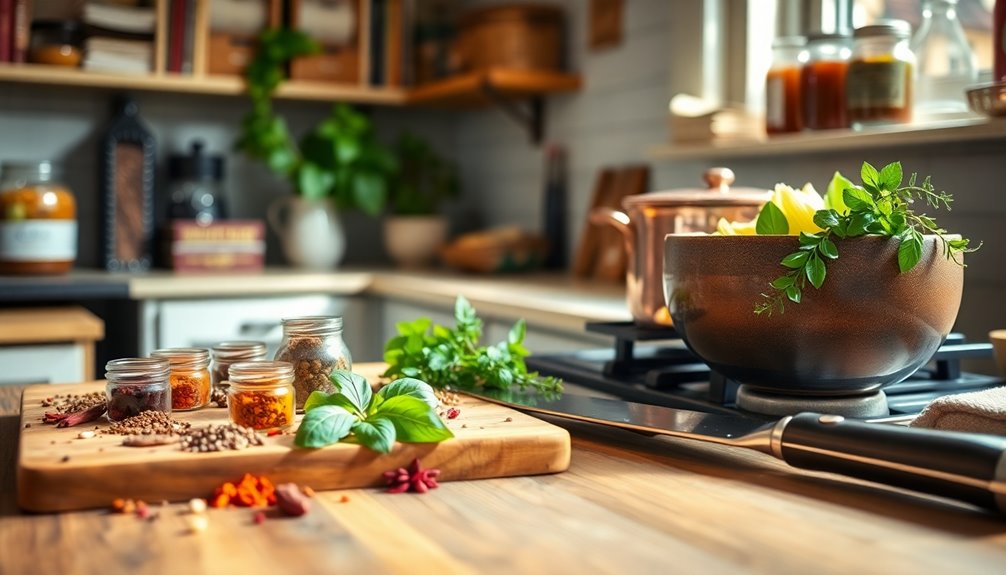
Chanakhi, a beloved traditional Georgian dish, has a history that stretches back centuries, showcasing the country's rich culinary heritage.
Often referred to as Georgian lamb stew, this dish embodies the spirit of communal dining, symbolizing hospitality and the joy of shared meals. You'll find that variations of Chanakhi exist across different regions, each incorporating local ingredients and unique flavors.
The slow-cooking method, rooted in ancient techniques from nomadic tribes of the Caucasus, allows the flavors to meld beautifully. Over time, Chanakhi has evolved, prominently featuring staples like lamb and eggplant, which thrive in Georgian agriculture.
This evolution highlights not just the dish's adaptability but also its deep connection to the land and its people.
Recipe
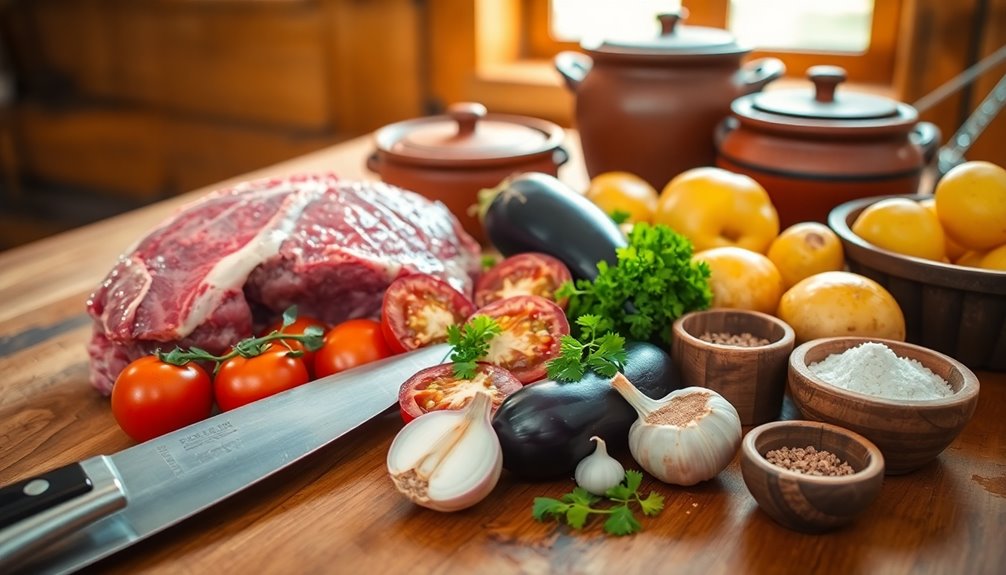
Chanakhi is a beloved traditional Georgian stew that showcases the rich flavors of lamb and an array of vegetables, slow-cooked to perfection. This dish is known for its unique layering technique, which allows the flavors to meld beautifully while retaining the individual characteristics of each ingredient. When prepared in individual clay pots, Chanakhi not only serves as a hearty meal but also as a delightful centerpiece for any gathering.
Chanakhi, a cherished Georgian stew, harmoniously blends tender lamb and vibrant vegetables, creating a perfect dish for any gathering.
To create this aromatic dish, you'll need to gather fresh ingredients and follow a straightforward preparation process. The key to a successful Chanakhi lies in the slow cooking, which allows the lamb to become tender and the vegetables to absorb the savory juices. This recipe will guide you through each step, ensuring that your Chanakhi is both authentic and delicious.
Ingredients:
- 1 lb boneless lamb shoulder
- 1.5 lb eggplant
- 5 Yukon Gold potatoes
- 10 Roma tomatoes
- 2 onions
- 4 cloves garlic
- Fresh herbs (such as coriander and parsley)
- Khmeli-suneli spice mix
- Salt
- Olive oil
Cooking Instructions:
Begin by salting the eggplant slices and letting them sit for about 30 minutes to draw out bitterness. Rinse and pat them dry.
In a large skillet, heat olive oil and brown the lamb shoulder pieces on all sides.
In individual clay pots, layer the ingredients starting with the browned lamb at the bottom, followed by sliced onions, minced garlic, and chopped tomatoes. Next, add the eggplant and diced potatoes. Sprinkle khmeli-suneli seasoning, salt, and fresh herbs between the layers.
Cover the pots and bake in a preheated oven at 300°F (150°C) for 4.5 to 5 hours, until the meat is tender and the flavors are well combined.
Extra Tips:
For the best results, use fresh, high-quality ingredients, especially the lamb and vegetables.
If you don't have clay pots, you can use a Dutch oven, but try to maintain the layering technique for optimal flavor.
Additionally, serving Chanakhi with crusty bread is a must, as it complements the dish perfectly and allows you to soak up the rich broth.
Garnishing with extra fresh herbs just before serving will enhance both the flavor and the visual appeal of this classic Georgian stew.
Cooking Steps
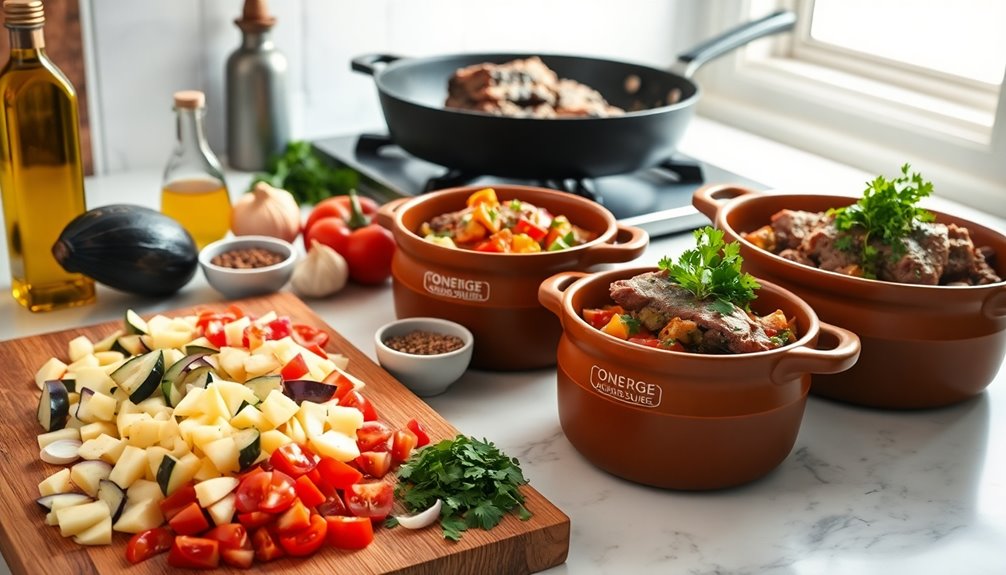
To kick off your Chanahi, you'll want to preheat your oven to 350°F.
Next, layer the vegetables in your pot, adding the browned lamb and spices for flavor.
Once everything's in place, let it simmer for two hours before finishing with fresh herbs.
Step 1. Preheat Oven to 350°F
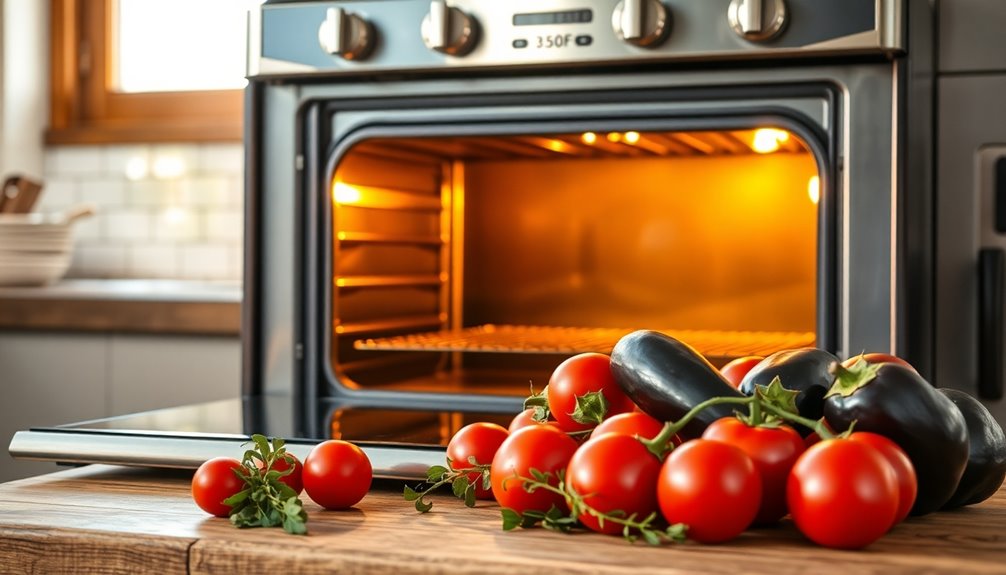
Preheating your oven to 350°F is essential for achieving perfectly cooked Chanakhi. This temperature allows the flavors of the lamb and vegetables to meld beautifully during the slow cooking process.
It takes about 10-15 minutes to preheat, so it's a smart move to start this step before you prepare your ingredients. Once your oven reaches the right temperature, you can confidently place your individual clay pots inside.
Maintaining the 350°F temperature throughout the cooking time is crucial to ensure your dish turns out tender and aromatic. This careful approach guarantees that every layer of your Chanakhi gets cooked evenly and thoroughly, providing a delightful meal that's bursting with flavor.
Enjoy the process!
Step 2. Layer Vegetables in Pot
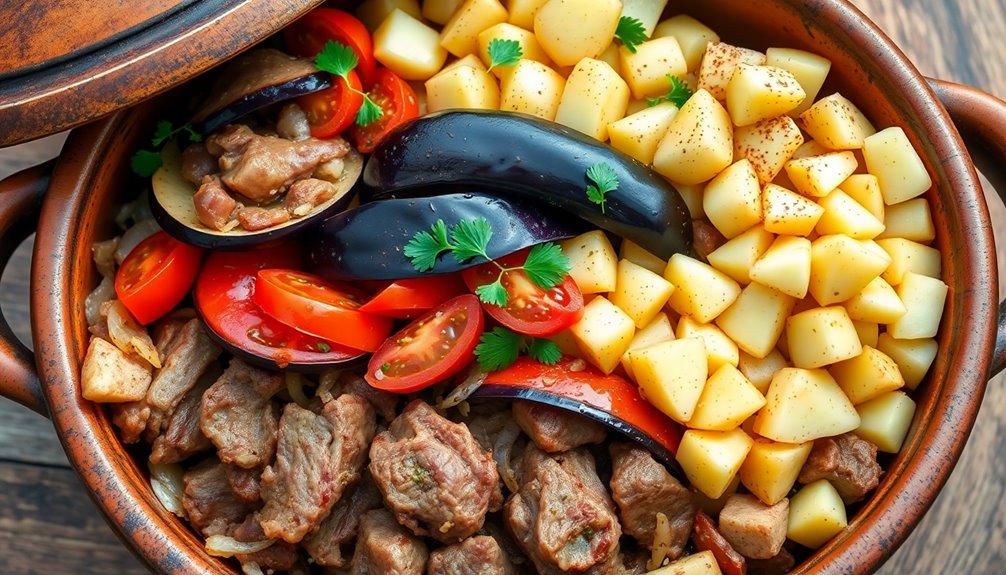
Layering the vegetables correctly is key to achieving a flavorful Chanakhi. Start by distributing the seasoned lamb evenly at the bottom of your pot. This ensures it cooks properly.
Next, add a layer of sautéed onions and green bell peppers on top of the lamb to infuse the meat with rich Georgian flavors.
Follow this with chopped tomatoes, pressing them down slightly to release their juices and create a savory sauce.
Continue with cubed Yukon Gold potatoes, which will absorb the flavors and add hearty texture.
Finally, top it all off with cubed eggplants, adding fresh herbs. Make sure the water level is just below the eggplants for even cooking, and you're set for a delicious dish!
Step 3. Add Lamb and Spices
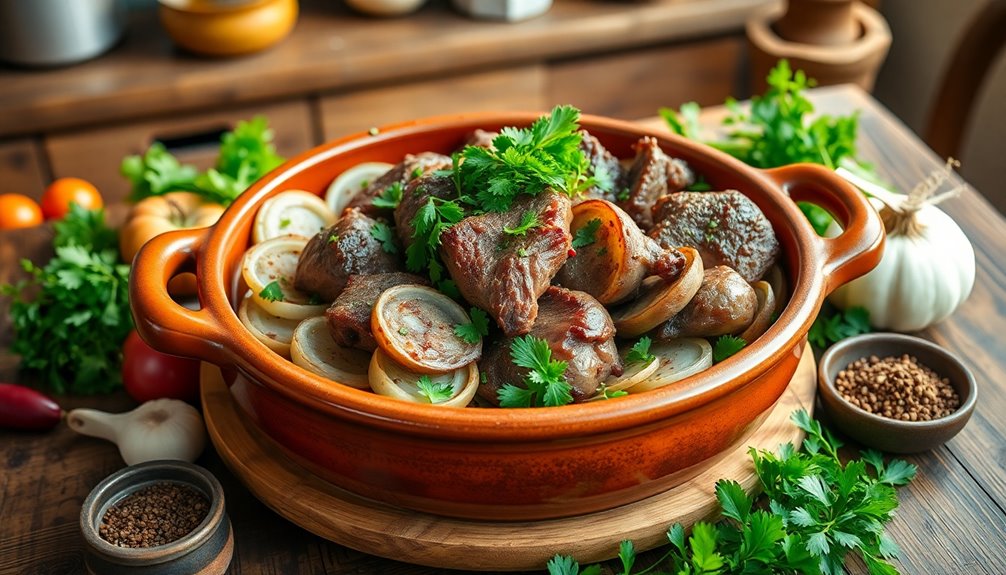
Once you've prepared your vegetables, it's time to focus on the lamb and spices. Start by browning 1 lb of cubed boneless lamb shoulder in vegetable oil over high heat for 3-4 minutes. This step enhances the meat's flavor, so don't skip it!
Season the lamb with salt and freshly ground black pepper to create a well-balanced dish. Next, sauté 1 large chopped onion and 1 large green bell pepper in the same oil until the onion turns translucent and golden, about 15 minutes.
Then, mix in 10 peeled and chopped Roma tomatoes, 3 pressed garlic cloves, and 1/2 cup of dry red wine, allowing the vibrant culture of flavors to develop for 15 minutes.
Layer everything together, finishing with fresh herbs.
Step 4. Simmer for Two Hours
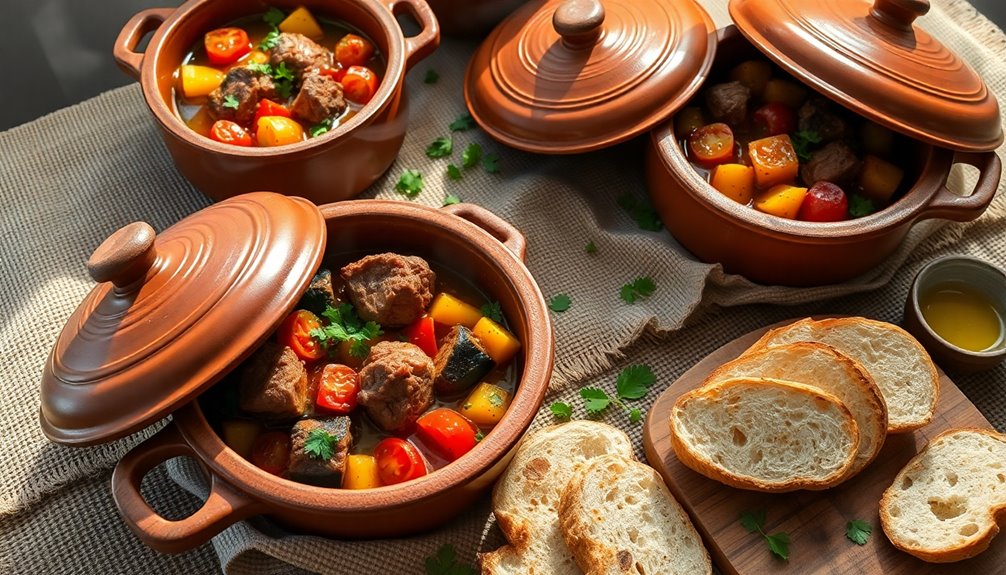
To achieve the best flavors in your chanahi, simmer the mixture for two hours. After layering the ingredients in your Dutch oven, cover it tightly to retain moisture.
Keep the temperature low, ideally between 300-325°F (150-160°C), to let the flavors meld without boiling. Periodically check the pot to ensure there's enough liquid, adding boiling water if necessary to prevent drying out.
During this time, the meat will become tender, and the vegetables will soften significantly. Gently stir the pot once or twice to evenly distribute the flavors, being careful not to break apart the delicate eggplant.
This slow simmering process is key to developing the rich, comforting taste that defines a great chanahi.
Step 5. Add Fresh Herbs Before Serving
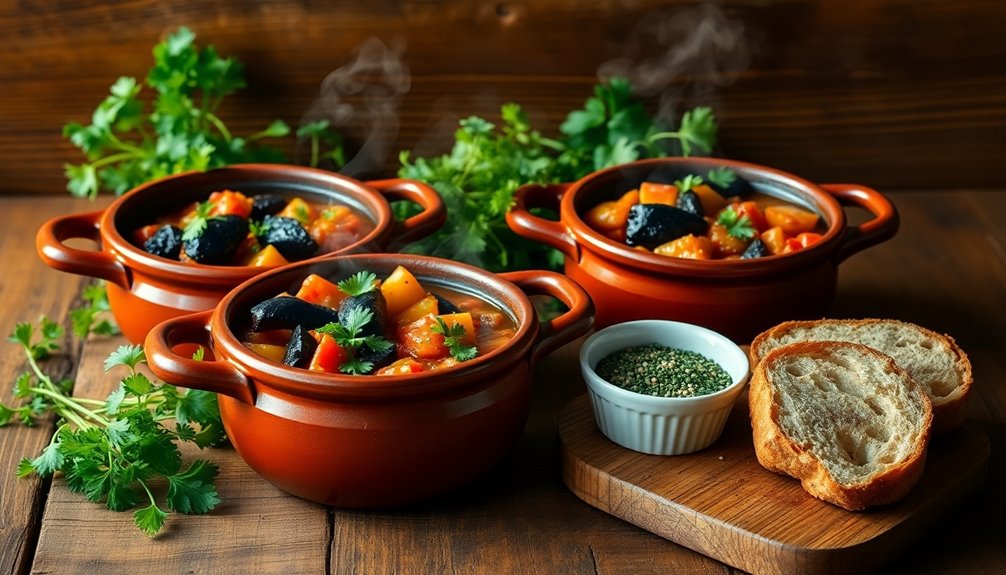
Adding fresh herbs just before serving can truly elevate your chanahi, as they introduce a burst of flavor and a splash of color.
When you sprinkle chopped fresh herbs like coriander or parsley on top, you're not just enhancing the dish's presentation; you're also adding a delightful aroma that contrasts beautifully with the rich stew. A small handful of fresh herbs in each individual serving pot creates an eye-catching garnish.
Remember, it's best to avoid cooking the herbs with the stew—this preserves their bright flavor and crisp texture. Plus, using fresh herbs enriches the taste profile and provides nutritional benefits, making your chanahi healthier.
Final Thoughts
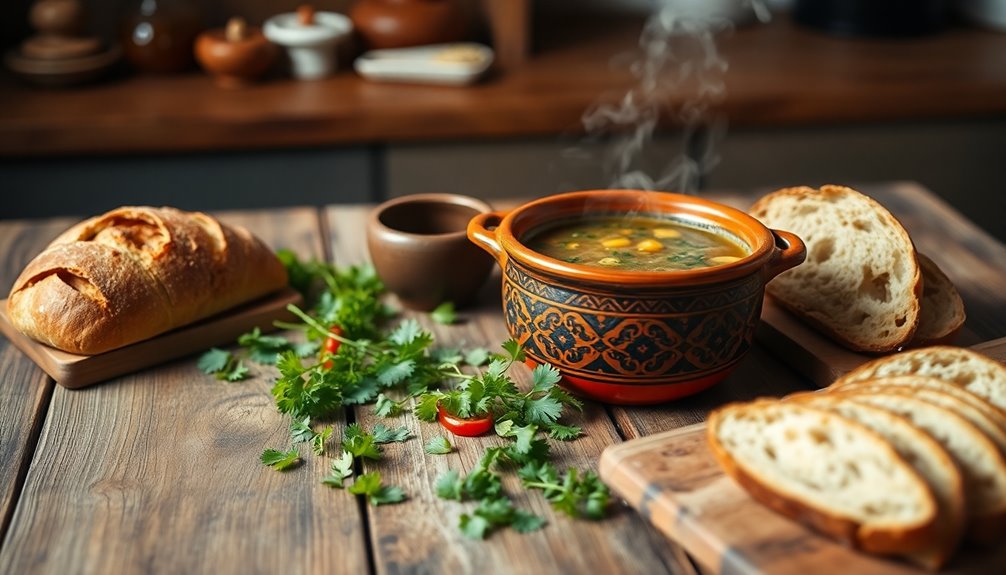
While enjoying a bowl of Chanakhi, you can't help but appreciate the depth of flavor and tradition this dish brings to the table.
This Georgian stew, slow-cooked at low heat, melds the rich tastes of lamb, eggplant, potatoes, and tomatoes, creating a comforting and hearty experience.
Prepared in clay pots, Chanakhi not only showcases its vibrant ingredients but also enhances the communal dining atmosphere.
The addition of fresh herbs and spices, particularly khmeli-suneli, elevates its unique flavor profile, making each bite memorable.
Don't forget to serve it with a crusty piece of Georgian Shotis Puri to soak up the flavorful broth.
As colder months approach, Chanakhi remains a beloved choice, warming both body and spirit.
Frequently Asked Questions
What Are the Origins of the Name "Chanahi"?
The origins of names can often be fascinating. They may stem from geographical locations, historical figures, or cultural elements.
You'll find that many names have roots in ancient languages, reflecting traditions and stories. Exploring etymology can reveal how meanings evolve over time.
When you dig deeper, you might discover connections to family heritage or regional significance. Understanding a name's background can provide insight into identity and shared history, enriching its value in your life.
Can Chanahi Be Made Vegetarian or Vegan?
Imagine a vibrant plate filled with colorful vegetables, fragrant herbs, and spices dancing together in harmony.
You can absolutely make chanahi vegetarian or vegan! Simply swap out any meat for hearty alternatives like chickpeas, lentils, or grilled vegetables.
Infuse rich flavors with aromatic spices and drizzle in some olive oil for that extra touch.
As you savor each bite, you'll find that the essence of chanahi remains, bursting with delightful tastes and textures!
How Do I Store Leftover Chanahi?
To store leftover food, start by letting it cool down to room temperature.
Once it's cooled, transfer the leftovers into an airtight container. Make sure to seal it tightly to prevent any air from getting in.
You can keep it in the fridge for up to three to four days.
If you want to store it for longer, consider freezing portions in freezer-safe bags or containers for up to three months.
Are There Any Traditional Side Dishes Served With Chanahi?
Yes, there are several traditional side dishes you can enjoy with this flavorful dish!
You might serve it alongside fragrant saffron rice, which complements the rich flavors beautifully.
Fresh salads, like tabbouleh or fattoush, add a refreshing crunch.
You can also include a side of grilled vegetables or pickled turnips for a tangy contrast.
Don't forget warm, fluffy pita bread to scoop up all those delicious flavors!
It makes for a well-rounded meal.
What Occasions Is Chanahi Typically Served At?
You might be surprised to learn that over 70% of traditional dishes are served during special occasions.
Chanahi is typically enjoyed at significant gatherings, such as weddings, family reunions, and religious celebrations. Its rich flavors and communal nature make it a perfect centerpiece for these events.
Whether it's a festive holiday or a casual family get-together, you'll find chanahi bringing people together, creating lasting memories and fostering connections among loved ones.
